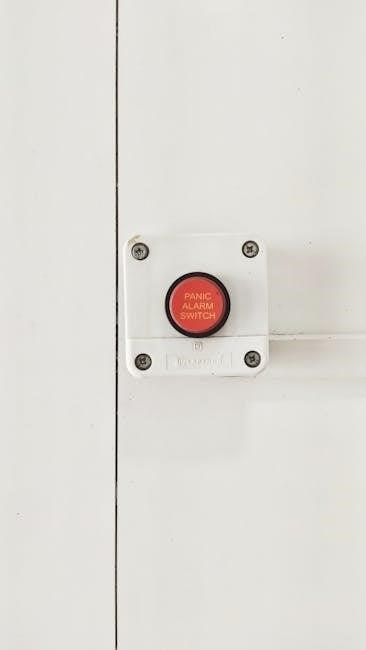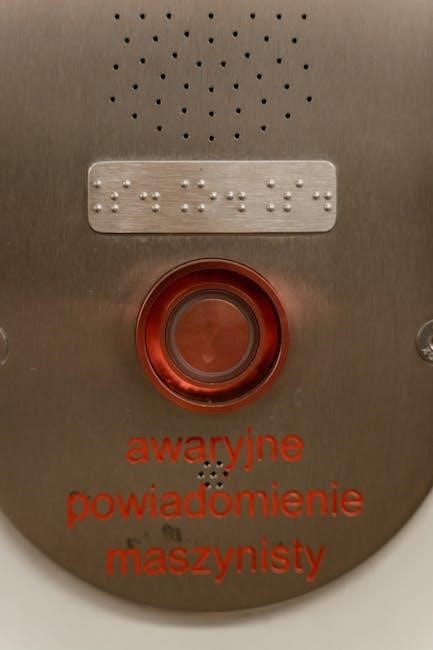Welcome to the DSC Security System user manual. This guide provides essential information for understanding‚ installing‚ and operating your DSC security system effectively.
Designed for reliability‚ the DSC system includes a control panel‚ keypads‚ and sensors to ensure comprehensive security coverage for your home or business.
Read this manual carefully to maximize system performance and explore advanced features for a secure and personalized experience.
1.1 Overview of the DSC Security System
The DSC Security System is a comprehensive solution designed to protect your home or business. It consists of a central control panel‚ keypads for user interaction‚ and a variety of sensors and detectors. The control panel is typically installed in an inconspicuous location such as a utility closet or basement. The system supports multiple zones of protection‚ each connected to specific sensors to ensure thorough security coverage.
1.2 Importance of the User Manual
The user manual is a vital resource for understanding and optimizing your DSC Security System. It provides detailed instructions for installation‚ operation‚ and troubleshooting‚ ensuring you get the most out of your security setup. By reading the manual‚ you can learn about system features‚ customize settings‚ and resolve common issues‚ enhancing both performance and security. Regularly reviewing the manual helps maintain a secure and efficient system for your property.

Components of the DSC Security System
The DSC Security System consists of a control panel‚ keypads‚ and various sensors and detectors. Each component plays a critical role in ensuring reliable security and seamless operation.
2.1 Control Panel
The DSC control panel is the central hub of your security system‚ managing all components and ensuring smooth operation. Typically mounted in a discreet location like a utility closet or basement‚ it processes signals from sensors and keypads. The control panel is essential for arming‚ disarming‚ and monitoring the system‚ providing real-time status updates and alerts. Its robust design ensures reliability and efficient control over your security setup.
2.2 Keypads
Keypads are essential interfaces for interacting with your DSC security system. They allow users to arm‚ disarm‚ and monitor the system‚ providing a user-friendly experience. Available in various models‚ including touchscreens and LCD displays‚ keypads offer features like proximity reader support and custom programming. They are typically wall-mounted for easy access and ensure convenient control over your security setup. Regular keypad maintenance ensures optimal performance and reliability.
2.3 Sensors and Detectors
Sensors and detectors are crucial components of the DSC security system‚ monitoring specific areas for potential threats. Motion detectors‚ door contacts‚ and glassbreak sensors are commonly used to trigger alarms. These devices are connected to the control panel and assigned to zones for precise monitoring. Customizable settings allow users to tailor sensitivity and responses‚ ensuring reliable protection. Proper installation and maintenance are essential for optimal performance and accurate threat detection.

Installation and Setup
The DSC system requires careful installation‚ starting with mounting the control panel‚ then connecting sensors and detectors‚ and finally configuring keypads for optimal functionality.
3.1 Mounting the Control Panel
Mount the DSC control panel in a secure‚ out-of-the-way location‚ such as a utility closet or basement. Ensure it is protected from tampering and moisture. The control panel is the brain of your security system‚ connecting keypads‚ sensors‚ and detectors. Follow installation guidelines carefully to ensure proper functionality and system performance. Secure the panel firmly to prevent unauthorized access or accidental damage. A stable installation ensures reliable operation and system integrity.
3.2 Connecting Sensors and Detectors
Connect sensors and detectors to the DSC control panel by identifying each device’s wiring and matching it to the correct zone terminals. Power down the system before starting to avoid damage or electrical shock. Strip wires as needed and secure them firmly to ensure reliable connections. Follow the manual’s wiring diagram for accurate zone assignments. After connecting‚ power up the system and test each sensor to confirm proper functionality. Address any issues promptly to maintain system integrity and performance.
3.3 Configuring Keypads
Configure keypads by connecting them to the control panel and assigning user codes. Follow the manual to program keypad settings‚ ensuring each keypad is synchronized with the system. Test all functions‚ such as arming‚ disarming‚ and zone bypassing‚ to confirm proper operation. Ensure the keypad display is clear and user-friendly‚ and store the manual for future reference. Proper configuration ensures seamless system control and enhanced security. Always follow safety guidelines during setup.

Arming and Disarming the System
Arm the system in Away or Stay mode using your code or key fob. Disarm by entering your code to deactivate all zones. Ensure silent arming for discreet operations and understand the process for system control and security.
4.1 Arming the System (Away Mode)
To arm the system in Away Mode‚ enter your access code at the keypad. The system will confirm arming with a beep or light. Ensure all zones are secure before arming. Away Mode activates all sensors‚ providing full protection. A brief exit delay allows you to leave the premises after arming. The system will alert you if any zone is triggered while armed.
4.2 Disarming the System
To disarm the system‚ enter your access code at the keypad. The system will confirm disarmament with a beep or light. All zones will deactivate‚ and any active alarms will stop. Ensure you disarm the system before entering protected areas to avoid false alarms. Disarming restores normal operation‚ allowing unrestricted movement within the secured premises without triggering sensors.
4.3 Silent Arming and Disarming
Silent arming and disarming allow you to activate or deactivate the system without audible confirmation. Enter your access code followed by the silent mode command (1 for arm‚ 2 for disarm). The system will indicate status via LED lights instead of beeps. This feature is useful for discrete operation‚ especially in noise-sensitive environments. Ensure silent mode is enabled in system settings for this functionality to work effectively;

Zone Management
Zone management allows you to organize and monitor different areas protected by your DSC system. Customize protection by assigning sensors to specific zones for tailored security.
5.1 Understanding Zones
Zones are designated areas within your DSC security system‚ each monitored by specific sensors or detectors. Understanding zones helps you customize protection‚ ensuring each area of your property is securely covered. Zones can be configured to trigger alerts or alarms when motion is detected or when a sensor is activated. Proper zone management enhances system efficiency and ensures tailored security for your home or business.
5.2 Assigning Sensors to Zones
Assigning sensors to specific zones allows you to customize your security system for precise monitoring. Each sensor‚ such as motion detectors or door contacts‚ can be linked to a zone‚ ensuring alerts are sent to the control panel when triggered. This setup enables you to identify exactly which area of your property is affected‚ enhancing response efficiency and system organization. Proper assignment ensures seamless operation and accurate notifications.
5.3 Bypassing Zones
Bypassing zones allows you to temporarily deactivate specific sensors or areas without disarming the entire system. This feature is useful when you need to allow movement in certain zones‚ such as letting a pet roam freely. To bypass a zone‚ enter your master code‚ select the bypass option‚ and choose the zone(s) you wish to deactivate. Remember‚ bypassing zones does not cancel the alarm entirely; it only excludes selected zones from triggering alerts during the bypass period.

Troubleshooting Common Issues
Identify and resolve common problems like error codes‚ sensor faults‚ or power issues. Check connections‚ test sensors‚ and consult the manual for detailed solutions.
6.1 System Error Codes
The DSC security system displays error codes to indicate specific issues. These codes help identify problems like sensor faults‚ communication errors‚ or power failures. Refer to the manual to understand each code’s meaning. Common errors include sensor tamper‚ low battery‚ or system communication issues. Addressing these codes promptly ensures optimal system performance and security. If issues persist‚ consult the troubleshooting guide or contact DSC customer support for assistance.
6.2 Resolving Sensor Faults
Sensor faults can occur due to tampering‚ poor connections‚ or environmental factors. Check sensor wiring for damage or loose connections. Clean sensors to ensure proper detection. If a sensor is faulty‚ replace it with a compatible model. Reset the system after addressing the issue. Test sensors by triggering them to confirm resolution. Refer to the manual for specific troubleshooting steps or contact DSC support for further assistance.
6.3 Battery and Power Issues
Battery and power issues can disrupt system functionality. Check power supplies and ensure all components are properly connected. Replace batteries with compatible models if depleted. Test sensors and keypads after replacement. If issues persist‚ inspect wiring for damage or corrosion. Verify that the control panel is receiving consistent power. Perform a system reset and test functionality. For persistent problems‚ consult the manual or contact DSC customer support for professional assistance.

Advanced Features
The DSC system offers advanced features like remote access‚ smart home integration‚ and customizable settings‚ enabling enhanced security and personalized control for users.
7.1 Remote Access and Control
Remote access and control enable users to manage their DSC security system from anywhere using a smartphone or tablet. This feature allows arming and disarming the system‚ checking real-time status‚ and receiving notifications; Integration with platforms like Control4 enhances smart home automation‚ providing seamless control of security and other connected devices. Remote access ensures convenience and peace of mind‚ offering advanced security management without physical interaction.
7.2 Integration with Smart Home Systems
The DSC security system seamlessly integrates with popular smart home systems‚ enhancing convenience and security. Compatible with platforms like Control4‚ Zigbee‚ and Z-Wave‚ it allows users to control lighting‚ thermostats‚ and security devices from a single interface. This integration enables automated responses‚ such as arming the system when leaving home or receiving alerts when unusual activity is detected. It simplifies home management and elevates your security experience.
7.3 Customizing System Settings
Customizing your DSC security system allows tailored security solutions. Adjust settings like zone configurations and user codes to meet specific needs. Advanced options include programming custom responses for sensor triggers‚ such as activating lights or sending notifications. These adjustments ensure the system operates precisely as desired‚ enhancing functionality and personalization for a secure environment. Detailed instructions are available in the official manual for precise customization guidance.

Maintenance and Updates
Regular maintenance ensures optimal performance. Update system software periodically and perform checks to maintain security and functionality for your DSC security system.
8.1 Regular System Maintenance
Regular system maintenance ensures your DSC security system operates efficiently. Check sensors for proper alignment and clean them to avoid false alarms. Verify power supplies and battery levels for wireless devices. Test backup systems and ensure all wiring is secure. Schedule annual professional inspections to identify potential issues early. Keep the control panel and keypads free from dust and debris for optimal performance. This routine upkeep guarantees reliable security and minimizes system downtime.
8.2 Updating System Software
Regular software updates are crucial for maintaining your DSC security system’s performance and security. Check for updates through the system interface or the manufacturer’s website. Always back up your configuration before updating. Follow the steps outlined in the official manual to ensure a smooth installation. Updates may include new features‚ bug fixes‚ or enhanced security protocols. Contact DSC support if you encounter any issues during the process.
8.4 Resetting to Factory Defaults
Resetting your DSC security system to factory defaults restores it to its original settings‚ erasing all custom configurations. This process is useful for resolving persistent issues or preparing the system for transfer. Access the control panel‚ enter the master code‚ and navigate to the system reset option. Follow the on-screen instructions carefully to complete the reset. Note that this will remove all user-defined settings‚ so ensure you have backups before proceeding. Consult the official manual for detailed steps and contact DSC support if needed.

User Manuals and Resources
Access official DSC manuals‚ troubleshooting guides‚ and customer support for comprehensive assistance with your security system. Visit the DSC website or contact support for detailed resources.
9.1 Accessing the Official DSC Manual
To access the official DSC manual‚ visit the DSC website or authorized portals like Manuals.ca. Search for your specific model‚ such as PC1616 or PC832‚ to download the PDF guide.
These manuals provide detailed instructions for installation‚ operation‚ and troubleshooting. They also include quick guides for arming/disarming and advanced features like remote access and zone management.
9.2 Online Troubleshooting Guides
DSC offers comprehensive online troubleshooting guides to help resolve common issues. Visit the official DSC website or platforms like Manuals.ca for detailed resources. These guides cover system error codes‚ sensor faults‚ and battery issues‚ providing step-by-step solutions. Additionally‚ specific model guides‚ such as for PC1616 or PC1832‚ are available to address unique system needs. Use these tools to diagnose and fix problems independently‚ ensuring optimal system performance and security.
9.3 DSC Customer Support
DSC provides dedicated customer support to assist with system-related inquiries. Visit the official DSC website for access to technical support‚ troubleshooting resources‚ and FAQs. Additionally‚ DSC partners with security professionals to offer personalized assistance. For complex issues‚ contact DSC support directly via phone or email for prompt resolution. Their team ensures your system operates smoothly‚ addressing concerns efficiently and effectively. This support enhances your overall security experience and system reliability.

Best Practices for System Use
Regularly inspect sensors‚ ensure passwords are secure‚ and keep the system updated. Train all users and conduct routine checks to maintain optimal security and functionality.
10.1 Ensuring System Security
To maintain the highest level of security‚ always use strong‚ unique passwords for system access. Regularly update software and ensure all users understand their roles. Conduct frequent security audits and keep the system free from unauthorized access. Train users to recognize potential vulnerabilities and report issues promptly. Secure physical components like keypads and sensors to prevent tampering. By following these practices‚ you ensure your DSC system remains reliable and robust.
10.2 Training Users
Proper training is essential for all users to understand system operations. Provide hands-on practice with arming‚ disarming‚ and managing zones. Ensure users know emergency procedures and how to handle false alarms. Regular refresher sessions can prevent misuse and ensure everyone stays updated on new features. Clear communication and accessible resources‚ like manuals or guides‚ help users feel confident and informed about their roles in system maintenance and security.
10.3 Regular System Checks
Regular system checks ensure optimal performance and reliability. Schedule monthly inspections of sensors‚ keypads‚ and the control panel. Test all zones for proper functionality. Check battery levels and replace them as needed. Review system logs to identify potential issues early. Ensure all users understand basic maintenance procedures to prevent false alarms and system downtime. Consistent checks help maintain your security system’s effectiveness and longevity‚ providing peace of mind and robust protection.